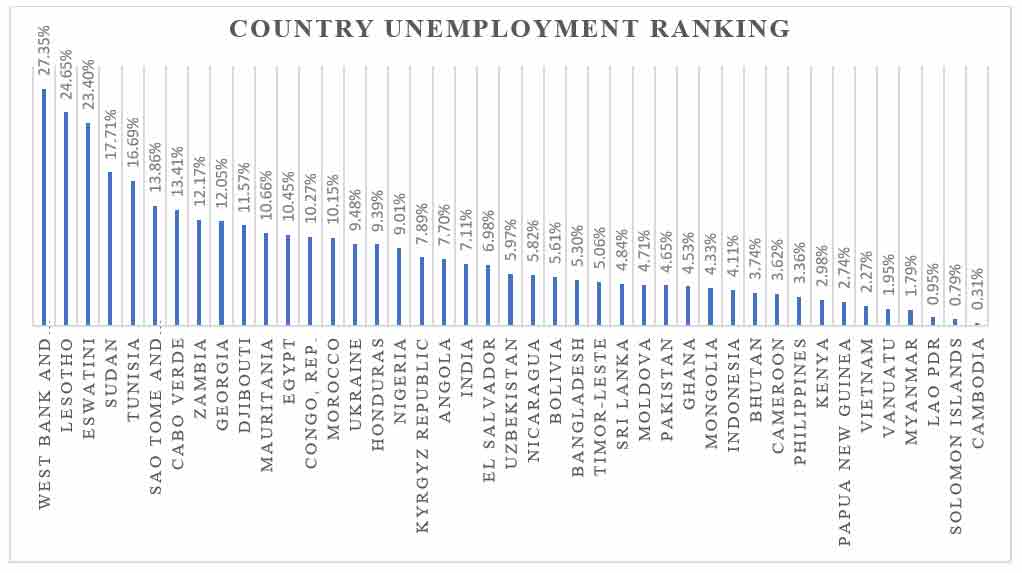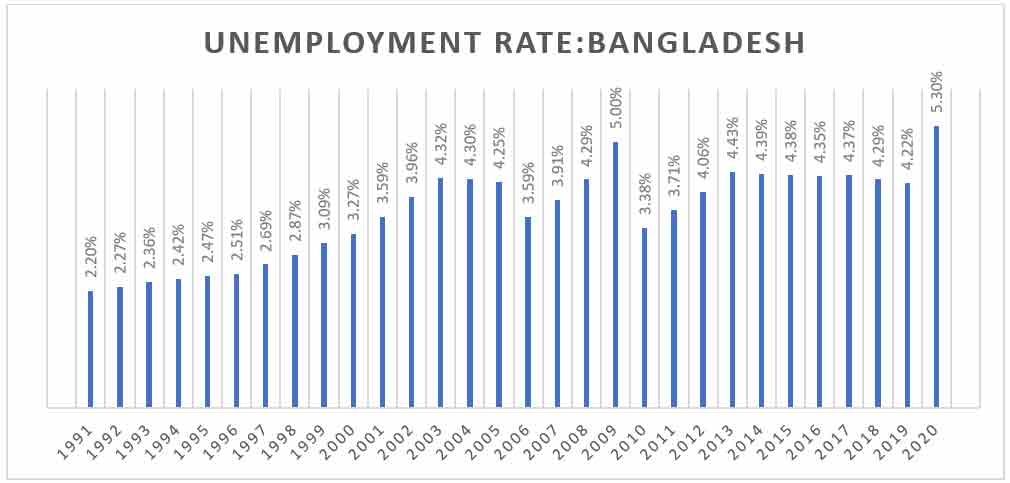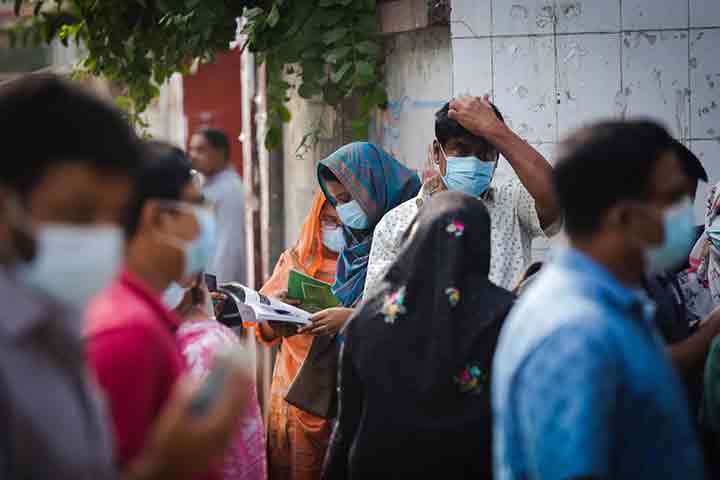Muhammad Mofizur Rahman
A person above a specified age not being in paid employment or self-employment is unemployment. Unemployment is measured by the unemployment rate, which is the number of unemployed people as a percentage of the labour force. Though, methods of calculation and presentation of unemployment rate vary from country to country. Mostly, it is differences in the age limit. So, the ILO (International Labour Organization) harmonized unemployment rate refers to those who are currently not working but are willing and able to work for pay, are now available to work and have actively searched for work. Also, the OECD (Organization for Economic Co-operation and Development) harmonized the unemployment rate, giving the number of unemployed persons a percentage of the labour force.

In 2020, the global unemployment rate amounted to 6.47 per cent, the highest in the last decade. And, the highest rate was 28.7% in South Africa, and the lowest rate was 0.1 in Qatar when this unemployment rate was 5.3 in Bangladesh at that time (Source: The World Bank, Statista, and Wikipedia).
The OECD published on 8 June 2021 that the unemployment rate increased marginally in April 2021 in the OECD area, to 6.6%, which is 1.3 percentage points above the pre-pandemic rate observed in February 2020.
The unemployment ratesare increasing day by day in Bangladesh. In the time of 1991-1998, the figure was between 2.20 and 2.87 in percentage. From 1999 to 2002, the numeral contained 3; the numbers gradually increased up to 2019 with some ups and downs. In 2019, the unemployment rate in Bangladesh was 4.22%, which became 5.3% in 2020, a 1.08% increase from 2019.Trading Economics global macro models and analysts expected that the unemployment rate in Bangladesh is expected to reach 6.00 per cent by the end of 2021. Also,the graduate unemployment rate of Bangladesh was 33.19 per cent in 2019 (Source: Bangladesh Institute of Development Studies-BIDS, ILO).

What are the reasons for high unemployment in Bangladesh?
There are a lot of problems for the unemployment situation in Bangladesh; a few of the prevalent causes of unemployment in Bangladesh are demonstrated here:
Overpopulation: Bangladesh ranks number 8 in the list of countries (and dependencies) by population. The current population of Bangladesh is 166,553,613 as of Sunday, 22 August 2021, based on Worldometer elaboration of the latest United Nations data. The population density in Bangladesh is 1,265 per Km2 (3,277 people per square mile). (The others high density are: Monaco-26,337, Macao-21,645, Singapore- 8,358, Hong Kong-7,140, Gibraltar-3,369, Bahrain-2,239, Holy See-2,003, Maldives-1,802, Malta-1,380).
Lack of capital: It is a little bit debatable about theper capita income. Based on ‘International Monetary Fund World Economic Outlook,’ The international ‘Statistics Times’ reported on 25 May 2021 that the per capita income of Bangladesh was $2,122 when it was $131,782 for Luxembourg (the highest). The Dhaka Tribune reported on 10 September 2021, “The per capita income of Bangladesh has now increased to $2,227, which is equivalent to Tk1,88,873, Planning Minister MA Mannan revealed on Monday.” Bangladeshi people have small savings because of lower per capita income. So, capital formation is not possible here, or only a small capital can be formed here. Lack of capital means no investment and employment.

Lack of technical education: Skilled labours are a basic need in all industries. Most of the Bangladeshi workers don’t have enough knowledge about the latest technology and skill. There is a skill gap in Bangladesh that will widen in future if the existing education system is not changed. According to the demand of national and global, the curriculum is not perfect based on modern technology. The education system of Bangladesh is still too rigid and theoretical and, in many cases, failing to meet the demands of the recruitment sector with the lack of technical knowledge. Often it is seen that graduates do not have the necessary know-how needed for their jobs.
Curriculum Gap:Around 85,000 foreigners legally work in Bangladesh, mostly in the export-oriented readymade garment (RMG) sector. But, industry insiders say, the number is much higher as many works without a valid work permit, and they remit the money through illegal channels. The curriculum of Bangladeshi education is not capable of covering this demand of industries. On the other hand, many populations work as labour in different countries, especially in the Middle East. Around 2 million Bangladeshi migrants are currently employed in Saudi Arabia. Most of them are totally unskilled and unable to contact their authorities for lack of communication knowledge. So, they are working there under leading peoples of Indian, Sri Lankan, and so on. For these reasons, they are getting pay less than other countries workers.
Agriculture dependency: About 50 per cent of the population are employed in the agriculture sector, and about 70 per cent of people overall depend on agriculture for their livelihood in Bangladesh. The seasonal unemployment problem occurs in agriculture. Furthermore, floods, cyclones, earthquakes and droughts are all common in Bangladesh, causing devastating upheaval to people’s lives who depend on agriculture. Climate change also making that more challenging. Every year many people get unemployed because of natural disasters such as river erosion, flood, cyclone, etc.
Corruption: Corruption is one of the significant problems of unemployment. Bangladesh has slipped two places in the Global Corruption Perception Index 2020 released by Transparency International (TI) and is ahead only of Afghanistan in tackling graft among its South Asian neighbours. The country is positioned at 146 among 180 countries in the latest rankings. Foreign investors feel disappointed because of corruption.
Political instability: Political instability and unskilled administration weakens our social structures. It brings fears to people on new investments. Political instability is likely to shorten policymakers’ horizons leading to sub-optimal short-term macroeconomic policies. It may also lead to a more frequent switch of policies, creating volatility and thus, negatively affecting macroeconomic performance. The unstable political situation hampered the long-term policies.

With the above reason, there are some other reasons which enhance the unemployment problem. Those are-
• Lack of investment
• Lack of women employment
• Indolent people
• Lack of proper industrial policy
• Contractionary fiscal policy
• Harassments in investment
• Lack of planning
• Improvements in artificial intelligence lower human labour.
Recommendation to solve the problem: Though Bangladesh is an overpopulated country, it is not the densest country globally. The density of Singapore is almost seven times that of Bangladesh. So, it is more important to use the people properly. The government needs to make humans human resources.Long-term and short-term policies should be implementedto make humans human resources. The most important thing is that it should be kept in mind that investment in education is not an expenditure. It’s the best investment for a nation in the world. So, there is no other alternative to increase the national budget for education, which should be a minimum of 7% of the national budget according to the guidance of international organizations. The educational system should be radical changes. The higher study should be restricted only for research-based.
Furthermore, a technologically based curriculum should be implemented for the national and global needed.Moreover, a country cannot improve its economy and unemployment crisis without industry-based development. So, it is essential to have a long-term policy for industrial improvement instead of only agricultural dependency. Even vast research should be encouraged for agriculture and agricultural equipment.Furthermore, digitalization may be a tool to control corruption. Also, highly punishments are essential for any type of corruption. The existing rules should be changed and appropriately utilized to prevent corruption. Properly policy adoption is the most crucial fact for any kind of solution to any problem. So, the political leaders and the nation’s authority should engage the experts for the respective purpose of the job without any kind of biased. Also, it should be allowed more budge for experts to research for correct decisions.

